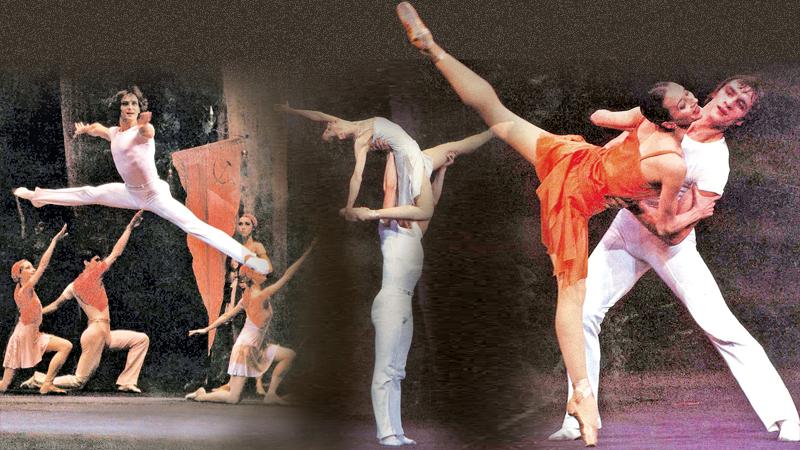
Life comes across in the Golden Age in the formation and play along with many colours of different forces. There is temptation and menace of the night. Yet, the opposite forces come on like a symphony moving against the light and no one but Grigorovich can manipulate such effects.
 There is a surge of natural sentiments and the dance is full of folklore. Here the world is doomed and condemned. In Act Two of this ballet, this is brilliantly displayed in the opening scene.
There is a surge of natural sentiments and the dance is full of folklore. Here the world is doomed and condemned. In Act Two of this ballet, this is brilliantly displayed in the opening scene.
The dance flows through different parts of the stage, slowly cutting across the floor from wing to wing while everything remains numb and just about dead. But the ritual tango movements are elegant belonging to silvery foliage. All seems being dispelled into nothingness that makes up just a small part of the Golden Age.
Spectacular ballet
The mention of Russian Ballet conjures a magical effect in all those who love ballet and are ardent fans, students and teachers of this fine art. Those who made Russian ballet happen are held in high esteem like guardians watchful up in its existence over the centuries and who are responsible for the spectacular ballet we see today.
Thanks to those devoted choreographers who have over the years strived hard and passed it down to us. Among such wonderous directors, today I am focused on Yuri Grigorovich who is is responsible for bringing together the classicism with passion and fire. He has joined the past with the present and let ballet speak out his devotion.
Moving over to a scene, there is the square and by the seaside are bright simple masts swaying in the wind and against the blue colour, the sky and sea wrap each other. There in the world of youth is the openness and space beckoning expanses of life in motion.
The Golden Age theme is one contrast as the future appears. The choreographer presents such scenes in modern and character dancing.
Each episode throws light forward to the next and deepen the sense. The dancers are subject to concentration while they dance.
Choreographic structure
The Golden Age is the ambiguous image without losing its spectator value while acquiring its ominous features.
The main events in the ballet come in major scenes. The plot specifies certain features in the overall picture to sharpen the image.
The events are not described by the choreographer in minute details and contain symbolic significances that reveal a choreographic structure on multi-level dancing.
In the successive waltzes, charlatans and gallops, they insistently and with vigour carve out new meaning to new steps.
The plot is built on unexpected happenings with captivating senses that make The Golden Age so different to other ballets.
The final scene comes out as a development of a symphony. The senses of the two finales are symbolic. Grigorovich’s choreography is a marvel. We find the invisible figure of time which flies pitilessly over life as something discovered anew. The Golden Age movement is never ending.
The score comes in the great composer, Shostakovich with his embodiment of lyrical ideas with a will of his own in the individual episodes.
The modern version of the ballet has picked up the march beats softened by warmish of soul. The variations are based according to the scenarios different to the original score.
Theme of love
The lyrical beginning produced by Shostakovich was marvellously developed by Grigorovich who maintained the theme of love through the whole ballet, love that elevates human emotion, the one that breeds life and for which many a sacrifice is made.
Tender recognition and flights of devotions reach the heights of passion. Shostakovich had them all in his music. These adagios with the corps-de-ballet reach the centre of the heart and touch the finest strings of the soul to reveal secret emotions.
The duets in the ballet are about general images of good, purity and humility.
The mass scenes display the lifestyle that links in term of drama and choreography.
These high strung emotions in a ballet can be conveyed only by the iconic touch of composer/choreographer combination, such as Shostakovich and Grigorovich.
Each of the three Acts finishes with lyrical themes. Love triumphs throughout the universe. It ends in romantic and victorious mood at the end of the Act 1.
They are all intriguing startling and passionate that sparkle through the acts the Golden Age reveals.
